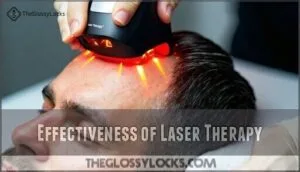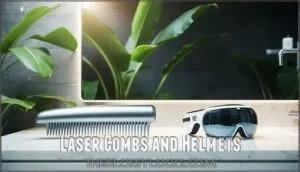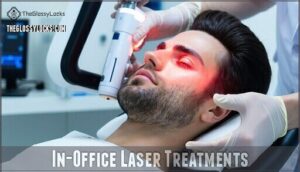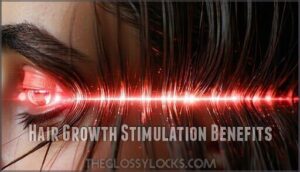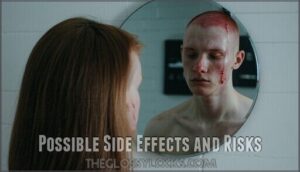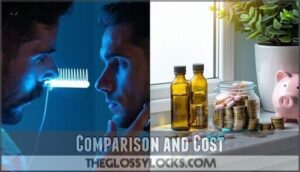This site is supported by our readers. We may earn a commission, at no cost to you, if you purchase through links.
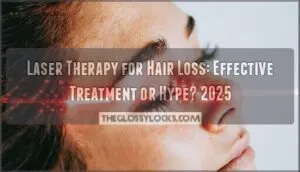
Clinical studies show modest improvements—think thicker, denser hair rather than dramatic regrowth. You’ll need consistent treatments for at least six months to see results, and benefits disappear once you stop.
It works best for early-stage hair loss and won’t resurrect completely bald areas. While FDA-approved devices exist, results vary substantially between individuals.
The science behind cellular stimulation and increased blood flow sounds promising, but the real-world outcomes often fall short of marketing claims.
Table Of Contents
- Key Takeaways
- Laser Therapy Basics
- Effectiveness of Laser Therapy
- Laser Therapy Devices
- Benefits and Risks
- Comparison and Cost
- Frequently Asked Questions (FAQs)
- Does laser treatment for hair loss work?
- Is laser hair therapy safe?
- What is low-level laser therapy for hair regrowth?
- How long does laser hair loss treatment take?
- Can laser light therapy reverse hair thinning?
- What are the pros and cons of low-level laser therapy?
- How much does low-level laser therapy cost?
- What other conditions can be treated by LLLT?
- Does laser therapy really work for hair loss?
- What is the success rate of laser hair therapy?
- Conclusion
Key Takeaways
- You’ll see modest improvements, not miracles – Clinical studies show that laser therapy increases hair density by about 39% over 16 weeks, but do not expect dramatic regrowth or restoration of completely bald areas
- Early intervention works best – The treatment is most effective for early-stage androgenetic alopecia; if you are already significantly bald, you will not see meaningful results
- Consistency costs time and money – You will need 20-30 minutes of treatment 3 times weekly for at least 6 months, with devices ranging from $200-$3,000 plus ongoing maintenance
- Results disappear when you stop – Any hair growth benefits you achieve will reverse once you discontinue treatment, making this a lifelong commitment rather than a permanent solution
Laser Therapy Basics
You’ve probably heard about laser therapy for hair loss but wonder if those red lights actually work or if it’s just expensive marketing.
Low-level laser therapy uses specific wavelengths of red light to stimulate your hair follicles at the cellular level, targeting the root causes of thinning hair through proven biological mechanisms.
What is Low-Level Laser Therapy
Low-level laser therapy (LLLT) harnesses red and near-infrared light to stimulate your hair follicles without invasive procedures.
This FDA-cleared technology delivers specific wavelengths between 600-950 nanometers to encourage cellular activity in your scalp.
Here’s what defines LLLT:
- Light Spectrum: Uses precise 655nm wavelengths for ideal hair follicle penetration
- Treatment Duration: Requires consistent sessions over several months for visible results
- Device Types: Available as laser combs, helmets, and professional clinic equipment
- Future Applications: Expanding beyond androgenetic alopecia to various hair loss conditions
How LLLT Stimulates Hair Growth
When your hair follicles receive lowlevel laser therapy, they’re basically getting a cellular wake-up call.
The red light boosts cellular metabolism and enhances blood flow to your scalp, improving tissue oxygenation around dormant follicles.
This photobiomodulation process triggers follicle reactivation, shifting more hair follicles into the active anagen phase for sustained hair growth stimulation, which leads to improved hair growth.
Proposed Mechanisms of Action
Scientists have identified several mechanisms behind photobiomodulation’s hair follicle stimulation effects.
Red light enhances ATP production by releasing nitric oxide from cellular components, boosting energy for follicular activity. This nitric oxide also triggers vasodilation, improving blood flow to your scalp.
Regular scalp massage techniques can also improve circulation.
The therapy activates stem cells and modifies gene expression, shifting dormant follicles into active growth phases while reducing inflammation.
Effectiveness of Laser Therapy
You’ve probably wondered whether laser therapy actually works or if it’s just another expensive hair loss gimmick.
The research shows promising results, with clinical studies demonstrating real improvements in hair density and growth for many people dealing with pattern baldness.
Clinical Studies and Research
Multiple randomized controlled trials have demonstrated LLLT’s treatment efficacy for hair loss research.
Clinical studies using proper control groups and patient selection criteria show consistent results. Seven clinical trials revealed increased hair density through rigorous data analysis.
Study designs comparing laser devices to sham treatments validate long-term outcomes, with meta-analyses confirming significant improvements in both men and women across various hair loss research protocols.
One example includes the HairMax Lasercomb which has shown significant improvements.
Success Rates for Hair Loss
Professional LLLT efficacy demonstrates impressive treatment effectiveness across clinical studies.
You’ll find success rates reaching 95% for hair regrowth within four months, with 97% of patients experiencing some benefit including hair density improvements or stabilization.
This therapy is also used for wound healing applications.
Here’s what the numbers reveal about your potential results:
- 84.6% of men achieve frontal regrowth – giving hope where you thought none existed
- 96.4% of women see vertex improvements – reclaiming confidence one session at a time
- 100% hair loss stabilization in men’s vertex areas after six months of consistent treatment
- 48% average increase in hair density – transforming thin areas into fuller coverage
- Long-term results improve substantially with treatments lasting over 180 sessions
Patient factors influence outcomes, with those having scalp conditions showing 34-51% better efficacy.
Hair regrowth requires reaching an 11% increase in terminal hair count from baseline, achieved by over 80% of users aged 18-40 through consistent treatment duration.
Factors Affecting Efficacy
Several factors determine whether laser therapy will work for your hair loss situation.
Your hair loss stage plays the biggest role – early-stage androgenetic alopecia responds much better than advanced baldness.
Device quality matters too, as FDA-cleared units show superior results in clinical studies.
| Factor | High Efficacy | Moderate-Low Efficacy |
|---|---|---|
| Hair Loss Stage | Early androgenetic alopecia | Advanced/severe baldness |
| Device Quality | FDA-cleared laser devices | Non-regulated light devices |
| Treatment Duration | 6+ months consistent use | Sporadic/short-term use |
| Skin Pigmentation | Light to medium skin tones | Very dark skin pigmentation |
| Concurrent Medications | No photosensitizing drugs | Taking light-sensitive meds |
Treatment effectiveness hinges on consistency – you’ll need months of regular sessions to see meaningful hair density improvements.
Skin pigmentation affects light penetration, while certain concurrent medications can cause unwanted reactions during treatment.
Laser Therapy Devices
When you’re ready to try laser therapy for hair loss, you’ll need to choose between handheld combs, helmet-style devices, or professional in-office treatments.
Each option delivers red light at specific wavelengths to stimulate your hair follicles, but they differ in convenience, cost, and treatment intensity.
Laser Combs and Helmets
Home laser devices offer you two main options for hair regrowth: laser combs and laser caps.
Device comparisons show both deliver similar helmet efficacy and comb usage results in clinical trials.
Your laser comb requires moving across your scalp, while laser hair therapy caps provide hands-free treatment.
Hair regrowth laser devices use wavelengths around 655nm with proven laser safety profiles.
Nutritional supplements aid hair strength and regrowth.
Future devices may combine both technologies for enhanced results.
In-Office Laser Treatments
Clinical professionals offer laser hair therapy through specialized equipment that delivers targeted wavelengths like 675nm.
Professional laser treatment protocols typically involve weekly sessions lasting several minutes to thirty minutes.
Treatment protocols in professional settings allow customized approaches based on your hair loss pattern.
Cost analysis shows clinic sessions range from hundreds to thousands of dollars, making clinic selection important for desirable results.
Many clinics offer specialized laser products for at-home use.
Home-Use Laser Devices
Many people find at-home laser devices more convenient than clinic visits.
Popular options include the laser cap and laser comb, which you can use while watching TV or reading.
These hair loss treatment devices require consistent use—typically 20-30 minutes, three times weekly.
Device comparisons show laser caps cover more scalp area than combs.
Many users seek detailed product insights before choosing a device.
Following usage guidelines matters: clean your scalp, charge the device, and stick to recommended schedules.
Expected results appear after 3-6 months with proper device maintenance.
Benefits and Risks
Before you weigh the pros and cons of laser therapy, you’ll want to understand what benefits researchers have documented versus potential risks.
The evidence shows promising results for hair growth stimulation, but like any treatment, you should consider possible side effects and medication interactions.
Hair Growth Stimulation Benefits
Now that you understand the device options available, let’s explore what benefits you can expect from laser hair growth treatments. Research shows LLLT delivers measurable improvements for many users experiencing pattern hair loss.
Your hair follicles respond to laser therapy through enhanced Cellular Metabolism and improved Blood Flow to the scalp. This combination supports Tissue Repair at the follicular level while promoting Follicle Reactivation of dormant hair growth centers.
Red light therapy awakens sleeping hair follicles by boosting cellular energy and blood flow to your scalp.
Benefits of laser hair growth stimulation include:
- Enhanced hair density – Studies show 15.27 more hairs per square centimeter after 26 weeks
- Stronger hair structure – Improved tensile strength makes existing hair more resilient
- Anagen Prolongation – Extended growth phase keeps hair follicles producing longer
- Non-invasive approach – Painless treatment without surgical procedures or harsh chemicals
The therapy works by triggering photobiomodulation in your scalp tissue, which kickstarts dormant follicles back into active hair regrowth cycles.
Possible Side Effects and Risks
Experiencing laser therapy side effects isn’t uncommon, but they’re typically mild.
You might notice temporary shedding initially—don’t panic, it’s normal.
Scalp irritation affects about 5% of users, while dry skin occurs in roughly the same percentage.
Some people develop light sensitivity or notice a warm sensation during treatment.
If you’re taking photosensitizing medications, discuss treatment interactions with your doctor.
Long-term effects remain largely unstudied, though current research suggests good longterm safety for hair loss treatment risks overall.
Medication Interactions and Precautions
You’re at higher risk for complications if you take photosensitizing medications before LLLT treatments.
Certain medications increase your skin’s light sensitivity, making laser treatments risky without proper medical guidance.
These drugs make your skin more sensitive to light, potentially causing burns or irritation.
Common photosensitizing drugs include certain antibiotics, antidepressants, and acne medications.
Always tell your doctor about all medications you’re taking, as they may need to adjust your treatment schedule or temporarily pause certain drugs to guarantee your underlying condition remains stable while maximizing longterm safety.
They may need to adjust your treatment schedule or temporarily pause certain drugs to ensure that you can undergo LLLT treatments without risking your underlying condition.
Comparison and Cost
You’re probably wondering how laser therapy stacks up against proven treatments like minoxidil and finasteride, and whether the hefty price tag is worth it.
The reality is that while LLLT shows promise, it’s substantially more expensive and time-consuming than traditional medications, with costs ranging from $200 to $3,000 for home devices plus months of consistent use, which can be a significant investment.
Laser Therapy Vs Other Treatments
When comparing hair loss treatments, you’re looking at a spectrum of options with different strengths.
Laser therapy offers a middle ground between medications and surgery.
| Treatment | Efficacy | Invasiveness |
|---|---|---|
| Laser Therapy | 12.79-16.96% improvement | Non-invasive |
| Minoxidil | 12.3% improvement | Topical application |
| Finasteride | 8.99% improvement | Oral medication |
| Hair Transplant | Permanent results | Surgical procedure |
Laser therapy matches minoxidil’s effectiveness while serving as a finasteride alternative without side effects.
Many patients find success using LLLT hair growth products.
It creates transplant synergy when combined with surgery and shows promise in PRP combination therapy for enhanced results.
Cost and Time Commitment
Treatment Duration for laser therapy stretches months, not weeks—you’re looking at 20-30 minutes per session, three times weekly.
Device Expense ranges from $200 for basic at-home laser devices to $3,000 for premium helmets. Clinic visits cost $75-150 per session.
Session Frequency demands consistency; skipping treatments resets progress.
Long-Term Costs add up quickly since hair loss returns without maintenance.
Hidden Fees aren’t common, but replacement parts and warranties increase expenses.
This time consuming, expensive treatment requires serious commitment.
| Cost Factor | Range |
|---|---|
| Home Devices | $200 – $3,000 |
| Clinic Sessions | $75 – $150 each |
| Treatment Duration | 4-6 months minimum |
Expert Opinions on Laser Hair Therapy
Beyond the dollars and hours invested, the medical community’s perspective on laser therapy shapes your treatment decisions.
Dermatologists and trichologists offer varying insights based on clinical experience and research outcomes.
| Expert Type | Primary View | Key Recommendation |
|---|---|---|
| Dermatologists | Cautiously optimistic | Combine with proven treatments |
| Trichologists | Supportive for early stages | Best for mild-moderate hair loss |
| Researchers | Evidence-based endorsement | More long-term studies needed |
Patient testimonials frequently highlight gradual improvements, while expert endorsements emphasize realistic expectations.
The dermatology field increasingly recognizes laser therapy’s role in holistic hair loss management, though future predictions suggest continued research will refine treatment protocols and patient selection criteria.
Addressing hair loss often involves exploring various avenues, including low level laser therapy, to stimulate hair follicles.
Frequently Asked Questions (FAQs)
Does laser treatment for hair loss work?
Like a gardener coaxing wilted plants back to life, you’re wondering if laser therapy can resurrect your thinning hair.
Yes, it works! Clinical trials show 39% increased growth over 16 weeks, stimulating follicles through red light photobiomodulation for mild-to-moderate hair loss.
Is laser hair therapy safe?
Yes, you’ll find laser hair therapy is generally safe with minimal side effects. Clinical trials show low adverse event rates, though some people experience temporary hair shedding initially.
What is low-level laser therapy for hair regrowth?
Low-level laser therapy uses red light wavelengths (typically 655nm) to stimulate your hair follicles, extending their growth phase and reactivating dormant ones for regrowth.
How long does laser hair loss treatment take?
Rome wasn’t built in a day, and neither is hair regrowth.
You’ll need consistent treatments 2-3 times weekly for several months before seeing results, with ideal outcomes typically appearing after 6 months.
Can laser light therapy reverse hair thinning?
Laser light therapy can help reverse hair thinning by stimulating dormant follicles and extending the growth phase.
You’ll likely see improvements in hair density and thickness, though results vary by individual severity.
What are the pros and cons of low-level laser therapy?
Like a double-edged sword cutting through hair loss confusion, you’ll find LLLT offers painless, non-invasive treatment with proven results, but requires expensive, time-consuming commitment with limited effectiveness for advanced baldness.
How much does low-level laser therapy cost?
Home LLLT devices cost $200-$3,000, while clinic treatments run hundreds per session. You’ll need consistent use for months, making annual costs reach thousands of dollars.
What other conditions can be treated by LLLT?
Beyond hair growth, you’ll find LLLT treats wound healing, nerve regeneration, joint pain, stroke recovery, and oral mucositis. It’s gained traction across dermatology and plastic surgery for tissue repair applications.
Does laser therapy really work for hair loss?
Yes, laser therapy effectively treats hair loss. Clinical studies show a 39% increase in hair growth over 16 weeks, with improved density and strength for both men and women with androgenetic alopecia.
What is the success rate of laser hair therapy?
Studies show laser therapy achieves approximately a 39% increase in hair growth over 16 weeks, with seven clinical trials demonstrating increased hair density in both men and women.
Conclusion
Overwhelmingly, laser therapy for hair loss is it effective remains a nuanced answer that deserves your careful consideration.
While LLLT won’t transform you into a shampoo commercial star overnight, it offers legitimate benefits for early-stage androgenetic alopecia.
You’ll see modest improvements in hair density and thickness, not dramatic regrowth, and success requires consistent use, realistic expectations, and understanding that results vary substantially between individuals.
Consider it a supportive treatment rather than a standalone solution for thorough hair restoration.

